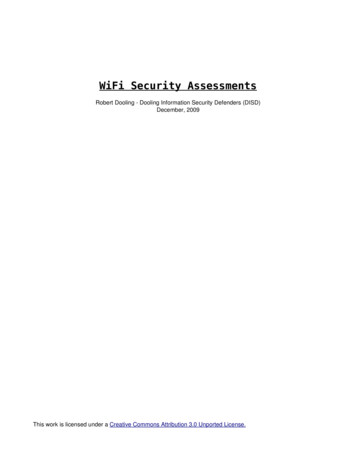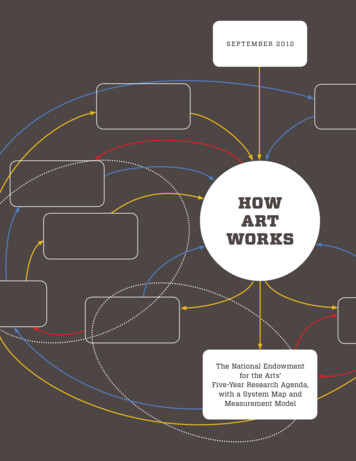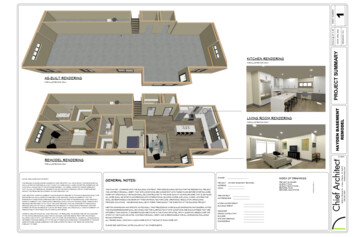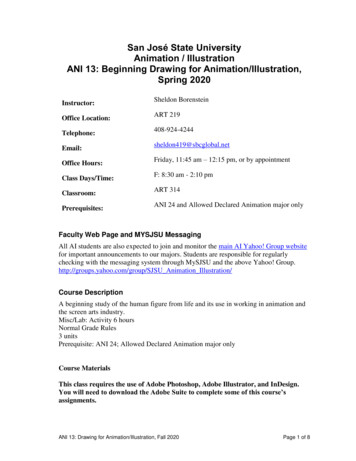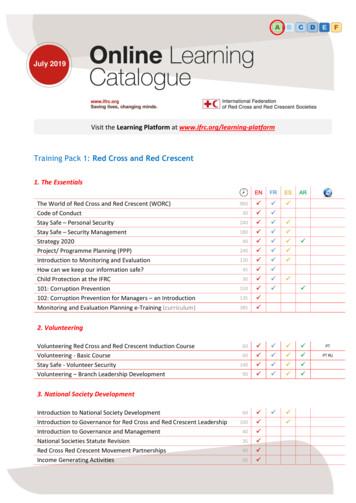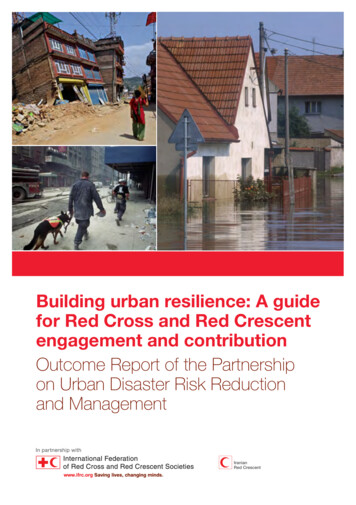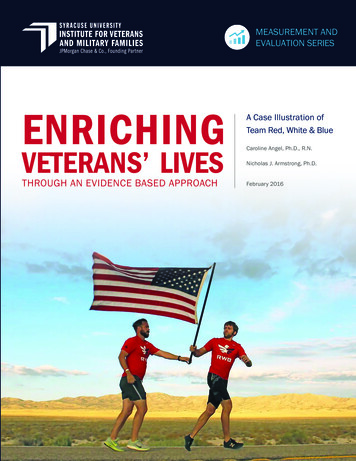
Transcription
MEASUREMENT ANDEVALUATION SERIESENRICHINGVETERANS’ LIVESTHROUGH AN EVIDENCE BASED APPROACHA Case Illustration ofTeam Red, White & BlueCaroline Angel, Ph.D., R.N.Nicholas J. Armstrong, Ph.D.February 2016
About the IVMF’s Measurement and Evaluation SeriesIVMF’s Measurement and Evaluation series focuses on the critical topics of program evaluation, performance measurement, and evidence-based practice. The series aims to promote greater learning,application of leading practices, transparency, and ultimately impact in service delivery across ournation’s community of organizations serving veterans and military families. The series will highlightexamples of organizations employing various approaches to evaluating and communicating impact.It will also include briefs and related tools to inform both providers and donors on leading practices,methods, and noteworthy developments in evidence-based practice.AcknowledgmentsThis collaboration and the efforts leading up to it would not have been possible were it not fora cadre of supporters. We are grateful to Mike Erwin, Lou Nemec, Carolyn Westlake, and LauraWerber for their contributions to the design, implementation, and analysis of the research anddata in this report. Special thanks also go to Dr. Mike Haynie and Mark Erwin for igniting thespark that ultimately led to the development of the Eagle Research Center. Team RWB wouldnot be what it is without a critical team of full-time executive staff who provide the leadership forthe 95,000-member organization, oversee the Team’s day-to-day operations, and value the importance of evidence-based programming. Many thanks to Team RWB leaders Blayne Smith, J.J.Pinter, Brandon Young, Dan Brostek, and Joe Quinn for your critical input and feedback on thecore knowledge, research, and writing of this report. Thank you to Team RWB Regional Directors, Zack Armstrong, Georgina Biehl, Garrett Cathcart, Brennan Mullaney, and Sarah Roberts.Additional thanks to Andrew Hutchinson, Laken Stutzman, John Willis, Nita Pennardt, DonnieStarling, Eric Engelhardt, and Patrick Griffith. We thank thousands of Team RWB members whohave participated in the research. Special thanks to Gabby Conlin, Kate Bielak, Jerry Wood,Dawn Boyle, Anthony Ritchie, and the Syracuse, New York Team RWB Chapter for your contributions to this study. We would also like to thank IVMF staff Bonnie Chapman and Kerry Manahanand research assistants Susana Santiago and Ryan Van Slyke for their contributions in the earlystages of this paper.This entire project, from data collection to publication, is volunteer-led and does not have any formalfunding or external sponsorship by either Team RWB or the IVMF.Suggested Citation (APA)Angel, C., & Armstrong, N. J. (2016). Enriching Veterans’ Lives Through an Evidence BasedApproach: A Case Illustration of Team Red, White & Blue (Measurement and Evaluation Series,Paper No. 1). Syracuse, NY: Institute for Veterans and Military Families, Syracuse University.
About the AuthorsCAROLINE ANGEL, PH.D., R.N.Caroline M. Angel is a Masters prepared psychiatric mental health nurse who holds a Ph.D. in Nursing andCriminology from the University of Pennsylvania. She is the Research Director for Team Red, White & Blueand has led Team RWB’s Central New Jersey Chapter since 2014. Angel is currently a Visiting Scholar at theUniversity of Cambridge. Her research has focused on posttraumatic stress, resilience, shame, forgiveness,health, and mortality. She has longitudinally followed a series of randomized controlled trials and was in aresearch or teaching role at the University of Pennsylvania between 1999 and 2014.NICHOLAS J. ARMSTRONG, PH.D.Nick Armstrong is the Senior Director for Research and Policy at the Institute for Veterans and Military Families(IVMF) at Syracuse University where he leads the IVMF’s growing portfolio of applied research, policy analysis,and program evaluation efforts. Armstrong is also an affiliated adjunct faculty member in Public Administrationand International Affairs at Syracuse University’s Maxwell School. Armstrong was previously a research fellow atthe Institute for National Security and Counterterrorism (INSCT) for six years where he led government and privatelysponsored security projects. Prior to this, Armstrong served for eight years in the U.S. Army with tours in Iraq (20052006), Afghanistan (2003-2004), and Bosnia (2001) with the 10th Mountain Division. Armstrong is a graduateof the United States Military Academy at West Point and the Maxwell School of Citizenship and Public Affairs atSyracuse University (Ph.D., M.P.A.).ContributorsMICHAEL ERWINMike Erwin is the Chairman of the Board and Founder of Team RWB; President of the Positivity Project(a non-profit organization whose mission is to strengthen leadership and relationships through a deeperunderstanding of character); and a Major in the U.S. Army Reserves. For the past year, Mike has served as theCEO of Susan Cain’s Quiet Leadership Institute. He is the co-author of a forthcoming book from BloomsburyPress, Solitude, Leadership, and Character. Mike graduated from the United States Military Academy at WestPoint in 2002. He was commissioned as an intelligence officer, serving in three combat tours with the FirstCavalry Division and 3rd Special Forces Group (Airborne). His service includes deployments to Operation IraqiFreedom in 2004-2005, Kandahar, Afghanistan, in support of Operation Enduring Freedom in 2006-2007and 2009. Mike currently lives in Pinehurst, NC, with his wife and four children.LOU NEMECLou Nemec is an active duty Soldier stationed at Fort Benning, Georgia. He became a volunteer leader withTeam RWB in the spring of 2012 while teaching at West Point with Mike Erwin. At West Point, Lou taught Intro toPsychology and Antrhopometrics/Biomechanics. He has been an integral part of welcoming all new members thatjoin Team RWB and is passionate about Team RWB research and Veteran research as a whole. Lou’s researchinterests include wellness, resilience, human performance, and the broad field of positive psychology. Lou and hiswife Lindsay have three boys that they raise in the spirit of ‘other people matter’. They enjoy running together whenpossible and have had the pleasure of engaging Team RWB members at events all across the country.CAROLYN WESTLAKECarolyn Westlake is currently obtaining a Master’s degree in Healthcare Data Analytics from Clarkson University.Prior to Clarkson, Carolyn earned a Bachelor’s degree in Exercise Science from Guilford College and a Masters inBiomechanics from the University of Tennessee.LAURA WERBERLaura Werber serves in two volunteer roles for Team RWB: she has been the Athletic Director for its Los Angeleschapter since May 2013 and joined the organization’s Board of Directors in January 2015. She is a Senior Management Scientist at the RAND Corporation, a non-partisan, nonprofit research institution, and also a Professor atthe Pardee RAND Graduate School. At RAND, she applies organizational theories and methods to a wide array ofpolicy issues, including community partnerships, Department of Defense workforce management, military families,and veteran reintegration. Laura is a graduate of the Wharton School of Business, University of Pennsylvania andearned a Ph.D. in organizational behavior from Stanford University.
ENRICHINGVETERANS’ LIVESTHROUGH AN EVIDENCE BASED APPROACHA Case Illustration ofTeam Red, White & BlueCaroline Angel, Ph.D., R.N.Nicholas J. Armstrong, Ph.D.February 2016
OverviewThis paper marks the launch of a new IVMF series focused on the critical topics of program evaluation,performance measurement, and evidence-based practice (EBP). The purpose of the series is to inform the broadercommunity of veteran and military family serving organizations by highlighting examples of veteran and militaryserving organizations employing various methods of EBP, program evaluation, and assessment. By highlightingleading practices across the U.S., this series aims to promote learning and greater impact in service delivery acrossour nation’s evolving and maturing community of veteran and military organizations.This case illustration highlights the evaluation efforts of the rising veteran and military serving organization Team,Red, White & Blue (Team RWB). Team RWB is a 501(c)(3) nonprofit organization founded in 2010 with the missionof enriching the lives of America’s veterans by connecting them to their communities through physical and socialactivity. Despite its relative youth, in 2014, the George W. Bush Institute’s (GWBI) Military Service Initiative andthe IVMF both identified Team RWB as a leading organization in building a robust measurement and evaluationprogram. The paper highlights how Team RWB integrates theory and research to drive its programming as anevidence-based wellness intervention and, in turn, produce data to inform its own organizational practice.Key Highlights Team RWB is an organization that values, at all levels, trust and transparency with its partners, funders, andcommunity. This culture—embodied by the ‘Eagle Ethos’ of positivity, passion, people, community, camaraderie,and commitment—exists throughout the organization from the senior executive down to the community level. Research and evaluation of RWB’s programs is and will remain vital to communicating its impact and improvinghow it targets resources to improve and grow its programs. The Team RWB “Eagle Research Center” is buildingan evidence base by quantitatively measuring its outcomes and using data to improve its program delivery. More than 1,800 veterans surveyed in 2014 and 2,500 surveyed in 2015 self-reported increases in creatingauthentic relationships with others, increasing their sense of purpose, and improving their health, by participatingin Team RWB. Veterans also noted that participating in Team RWB had indirect benefits in their familyrelationships and work. Improvements on these dimensions contribute to an enriched life, with more programengagement leading to more enrichment. Team RWB achieves these results through local, consistent, and inclusive programs. The chapter andcommunity programs provide opportunities for physical, social, and service activities. The LeadershipDevelopment Program is comprised of national athletic and leadership camps, and a newly launched tieredleader development program.iii
TABLE OF CONTENTSExecutive Summary.iiIntroduction. 3The Founding Story of Team Red, White & Blue. 4The Origins .4Early Reflection, Learning, and Evolution .4Not ‘Just Another Running Group’—Advancing Understanding of RWB’s Purpose.6Operational Model .7Chapters and Communities .7Veteran Athletic and Leadership Camps . 8Leadership Development Program. 8Signature Events and Collaborative Activities. 9Team Emblem and Gear as Symbol of Unity. 9The Importance of Civilian Membership. 9Team RWB as an Evidence-Based Wellness Intervention. 10Striving for Outcomes via the Team RWB Annual Member SurveyTeam RWB Builds Authentic Connections .11Team RWB Increases Sense of Purpose throughCivic Engagement Opportunities.14Team RWB Promotes Wellness through Physical Activity.17Team RWB Builds Civilian-Military Solidarity.18Team RWB Indirectly Improves Veterans’Family Lives and Employment Outcomes.18Discussion and Implications. 18Conclusion.21References.22Appendix.24
2
IntroductionToday the nationwide community of veteran and military serving organizations faces an inflection point.Barring widespread outpouring of public support for the military over the past 15 years, the financialside of the “sea of goodwill” (R. Cohen, 2013; Copeland & Sutherland, 2010) seems more like a slowlyebbing tide. Given a closer look, the proceeds toward veteran and military-specific organizations remainflat since 2001 (P. Carter & Kidder, 2015a, p. 15). In fact, compared to a steadily growing nonprofitsector overall, veteran and military serving organizations now capture a lesser, and declining, share oftotal philanthropic support than they enjoyed in the months following 9/11. This trend suggest signs ofconsolidation, even in the midst of soaring, albeit uncertain, federal spending on military personnel andveterans programs (pp. 12-13).Yet, given higher injury survival rates and the degree of veterans’ resulting physical and mental healthneeds, the costs of care for Iraq and Afghanistan veterans will “easily surpass 1 trillion in the comingdecades” (Bilmes, 2016, p. 14). Veterans’ needs, however, ostensibly occur in clusters (P. Carter & Kidder,2015b; Castro, Kintzle, & Hassan, 2014; Schell & Tanielian, 2011; Zoli, Maury, & Fay, 2015), such as,the concurrent need for housing, a job, and legal or financial assistance. And for the local organizationswho serve veterans daily, competition for increasingly scarce resources is very real. As a result, veteranand military serving organizations, most of which are small in size and revenue, confront a likely future oflearning to do more with less. Donors, too, are sharpening their focus on the impacts of their investmentsby demanding grantees measure outcomes and, in some communities, employ evidence-based practices,or measure the combined, or collective, impact of multiple organizations working together (Armstrong,McDonough, & Savage, 2015).The implications are clear. Organizations that clearly demonstrate their outcomes will not only remainattractive to current and future donors, but also position themselves to best serve veterans’ needs.Evidenced-based practice (EBP), as adapted from the field of medicine, applies the best availableresearch, provider expertise, and clients’ values and circumstances to deliver high-quality programs andservices (Sackett, Rosenberg, Gray, Haynes, & Richardson, 1996). EBP is essential to gauge programeffectiveness, establish leading practices and benchmarks, garner insight for learning and innovation,and provide transparent reporting to key stakeholders (i.e., funders, partners, and clients). EBP is also acore component of ethical practice (A. Taylor, Harold, & Berger, 2013) and a clear sign of organizationalmaturity, especially for organizations that seek evidence and impact measures beyond their funders’minimum requirements (GWBI & IVMF, 2015).THE IVMF MEASUREMENT AND EVALUATION SERIESGiven the current environment, this paper marks the launch of a new IVMF series focused onthe critical topics of program evaluation, performance measurement, and evidence-based practice.The purpose of the series is to inform the broader community of veteran and military family servingorganizations by highlighting examples of veteran and military serving organizations employing variousmethods of EBP, program evaluation, and assessment. In addition, the series will also include briefs andtools to inform both providers and donors on leading practices, methods, and noteworthy developmentsin EBP across the veteran and military community. By highlighting leading practices across the U.S., thisseries aims to promote learning and greater impact in service delivery across our nation’s evolving andmaturing community of veteran and military organizations.3
TEAM RED, WHITE & BLUE: A LEADING EXAMPLE IN DEVELOPINGAN EVIDENCE-BASEThis first paper is a case illustration of the rising veteran andmilitary serving organization Team, Red, White & Blue (TeamRWB). Team RWB is a 501(c)(3) nonprofit organization foundedin 2010 with the mission of enriching the lives of America’sveterans by connecting them to their communities throughphysical and social activity. Despite its relative youth, in 2014,the George W. Bush Institute’s (GWBI) Military Service Initiativeand the IVMF identified Team RWB as a leading organization inbuilding a robust measurement and evaluation program (2015,pp. 24-25). To follow from this prior research, this paper revealshow Team RWB integrates theory and research to produce datathat informs its own organizational practice.The paper is organized into three sections. First, we providea background of Team RWB’s founding story and evolutionto its current operational model. The story is important tohighlight, not only for background, but to explain how the Teamevolved—though trial and error, learning, and reflection—todevelop a clear mission and ‘theory of change’. Second, wepresent the underlying psychological, biological, and socialtheories that support Team RWB as an evidence-based,community health intervention. Finally, we outline recentfindings from member surveys to demonstrate Team RWB’sprogrammatic outcomes on participating veterans’ enrichmentand discuss broader implications for practice and policy.The Founding Story of Team Red,White & BlueThis section highlights Team RWB’s founding story and servestwo purposes. First, it offers insights into how and why theorganization emerged, how it’s organized, and the range ofactivities and programming it delivers nationwide. Second,and more importantly, it reveals how Team RWB has evolvedto develop a clearly defined mission and a “theory of change”(Poister, 2003, pp. 35-38) for how its various activitiesand programs produce positive outcomes for veterans andcommunities.THE ORIGINSFormer U.S. Army Major Mike Erwin founded Team RWB inJuly 2010 while attending graduate school at the University ofMichigan, studying positive psychology under the field’s cofounder, the late Dr. Chris Peterson. With roughly 200,000 servicemembers transitioning out of the military each year (VA, 2007,2014) and roughly two in five departing for communities otherthan their former hometowns (DMDC, 2015), Erwin observed thatmany veterans, particularly wounded warriors, desired support inbuilding connections within their new communities. Erwin, having4realized an apparent gap in services, embarked on creating anorganization that provided a consistent and inclusive supportstructure for veterans, embedded within local communities, andcentered on physical and social activity. The organization wouldbe appropriately named Team Red, White & Blue—or better knownas Team RWB.Team RWB has evolved and matured considerably in shorttime from its genesis in Ann Arbor, Michigan. The organizationinitially launched as a one-on-one, veteran and advocaterelationship program designed to help struggling veterans incommunities. Physical fitness was viewed as the core elementwithin a broader model to raise public awareness, sponsorship,and fundraising to support the initial mentorship program’sdelivery. Team RWB concentrated its efforts on participationand promotion in endurance events (e.g., marathons,triathlons, etc.), to grow a national network of leaders andadvocates through which to build one-on-one relationship withveterans in communities.To raise awareness, RWB recruited athlete-fundraisersto compete in endurance races. To promote a supportivecommunity, RWB created local networks of advocates toconcentrate their efforts and connect wounded veteran familiesto donors, athlete-fundraisers, and supporters. The one-on-onerelationships were essential—they linked veterans and theirfamilies to other local community members and veterans able toprovide tailored support.EARLY LEARNING, REFLECTION, AND EVOLUTIONDespite the best intentions of many, however, this initialpush led to inconsistent support to veterans and misplacedsponsorship over partnership. This early learning experienceshifted Erwin’s and Team RWB’s mission focus to providingconsistency of social interaction for veterans by growing a socialleadership-based community.Still, as with many young start-ups, Team RWB evolved withtime and sharpened its focus through reflection and learningfrom its members and advisors. In the summer of 2011, Dr.Brené Brown visited West Point where Erwin was teaching at thetime. Brown, a research professor at the University of Houston’sGraduate College of Social Work, remains a respected andsought out expert on vulnerability, courage, authenticity, andshame. From her visit and continued dialogue with Erwin onthe indiscriminant nature of pain and suffering emerged therealization and potential value of Team RWB as a resource, notspecifically for visibly wounded veterans, but for all veteransreintegrating back into society.In addition, later that fall, veterans who had joined TeamRWB were attesting to the benefits that physical activity playedin their reintegration and, for some, recovery process. Team RWBleadership also recognized the opportunity to expand outreachthrough greater inclusion and decided to build a team that wouldENRICHING VETERANS’ LIVES THROUGH AN EVIDENCE BASED APPROACH
allow its members to open up or reach out for support on theirown as they achieved a level of comfort with others.In May 2012, a leading consulting firm conducted a strategicplanning assessment of Team RWB. The firm interviewed membersfrom five of its existing chapters at the time (Washington, D.C., AnnArbor, Syracuse, Houston, and Chicago). A strong theme emerged.Local leaders and members held the firm and consistent beliefthat relationships—between team and community members—werethe core of Team RWB’s purpose and long-term impact. While thiswas not explicit within Team RWB’s mission statement at the time,the strategic assessment clearly revealed that building qualityrelationships captured how the organization was enriching the livesof America’s veterans and their families.Erwin’s leadership team grew following the strategic reviewin October 2012, starting first with the hire of Blayne Smith asthe Director of Operations. By January 2013, Erwin steppeddown as Executive Director as he was still serving on active dutyand sought to charge one leader with full-time responsibilityto implement the new strategic vision and manage theorganization’s rapid growth in membership. Consequently, hehired a new Director of Operations, J.J. Pinter, and appointedSmith to Executive Director.Team RWB’s new strategy included several changes tothe population it served. Team RWB leadership realized thatthe majority of members were joining as volunteer advocatesrather than self-identifying as wounded veterans (regardlessof their disability status). They also found those volunteerA CASE ILLUSTRATION OF TEAM RED, WHITE & BLUEadvocates were reporting a renewed sense of unity andpurpose through their participation. Team RWB leadershipsought to instill a greater sense of camaraderie, identity, andpurpose through regular physical activities and social eventsthat would drive veterans to connect to a chapter within theircommunities.In all, the insights gained in the early years allowed TeamRWB to evolve into a more inclusive organization that servesall veterans, active duty military, military families, and civilians.Team RWB’s inclusion of civilian members (and leadership)distinguishes it from most veteran organizations. Simply put,being more inclusive to those without prior military service putsveterans at a greater advantage than if the Team was exclusiveto veterans only. In theory, these expanded social connections—beginning as “weak ties” (Granovetter, 1973) and transformingover time into powerful forms of social capital (Coleman, 1988)—ideally provide veterans greater access to local resources,knowledge, and opportunities (e.g., schools, jobs, services) intheir new communities.Civilian team members benefit too. RWB provides an outletfor local citizens seeking opportunities to meet, demonstratetheir support for, and build authentic relationships with veteransin their community through genuine interaction. Although TeamRWB’s principal goal is to enrich veterans’ lives, broad inclusionalso facilitates communication across the often-cited ‘civilianmilitary divide’ and promotes greater societal understanding ofmilitary service.5
NOT JUST ANOTHER RUNNING GROUP—ADVANCINGUNDERSTANDING OF TEAM RWB’S “THEORY OF CHANGE”By 2013, Team RWB saw an explosion in new membership.But with this rapid growth, arose a perception that the groupwas just a physical fitness group for veterans who mostly runor do CrossFit workouts together. While running and functionalfitness are two popular activities for some, this perceptionmisses Team RWB’s true purpose and intent—its raison d’être—and captures, at best, a surface-level understanding of itsfounding vision. Team RWB’s activities, in fact, go well beyondphysical fitness for fitness’s sake. But as many RWB leadersattest, communicating the organization’s broader theory ofchange has been and remains a high priority.Ultimately, Team RWB was founded on the simple, yetsignificant, truth that “other people matter” (Peterson, 2008).More than any other factor, strong ties to individuals and alarger social network are the key ingredients to living a happierand more fulfilled life (Cacioppo & Patrick, 2008; Diener &Seligman, 2002; Valliant, 2012). And connectedness to others,that is, secure attachments and social support (Pietrzak &Cook, 2013) is a major protective factor against developingphysical and behavioral health problems, including early death(Cacioppo & Cacioppo, 2014; Holt-Lunstad, Smith, & Layton,2010). The transition from active military service to civilian lifemarks a significant disruption in a veteran’s sense of socialconnectedness. Accordingly, RWB’s mission to enrich veterans’lives by developing authentic connections through physical andsocial activity translates decades of multidisciplinary research,spanning the fields of psychology, neuroscience, and sociology,into best practice. We discuss this firm grounding in research ingreater depth later in the paper.Through much internal discussion, Team RWB’s leadership teamhas developed a well-formulated outcome concept of ‘enrichment,’defined as creating quality relationships and experiences thatcontribute to life satisfaction and overall wellbeing. Consistentwith Berglass and Harrell’s (2012) veteran wellness model, theconcept of enrichment consists of three core components—people,health, and purpose—that define a rich life (Smith, 2016). True toits roots, Team RWB’s focus on ‘People’ relies on creating authenticconnections (defined as genuine, quality, supportive relationshipsthat generate mutual trust and accountability), reflected in anincreased number of close relationships and improvementsin teammates’ sense of belonging, purpose, and communityengagement. Team RWB’s ‘Health’ focus creates frequentopportunities for team members to connect through fitness,sports, and recreation to improve physical, mental, and emotionalFigure 1. Team RWB Events and Attendance (2015)TEAM RWB EVENTSLocal races andathletic eventsLocal, consistentexercise eventsCommunityservice eventsSocial eventsOther eventsEVENT ATTENDANCECIVILIAN6VETERANENRICHING VETERANS’ LIVES THROUGH AN EVIDENCE BASED APPROACH
wellbeing. Team RWB also enhances members’ ‘Purpose’ byengaging them in meaningful team and community-basedexperiences such as leadership and service that, beyond physicaland social activities, renew self-identity and purpose in life.OPERATIONAL MODELTeam RWB’s operational model focuses on delivering local,consistent, and inclusive activities designed to build a communityof-communities. Headquartered in Tampa, Florida, Team RWB is aregistered nonprofit organization staffed primarily by volunteers. Asof early 2016, the organization has only seventeen full-time paidemployees dispersed nationwide across six regions: Northeast,Mid-Atlantic, Southeast, Midwest, Pacific, and South Central. Theorganization continues to grow since its official launch in 2012and has reached new heights with 172 chapters and communitiesworldwide, covering five countries (United States, Italy, England,Korea and Japan) and territories (Guam) and registeringapproximately 500 to 700 new members per week.The operating model is guided by a unique set of fundamentalbeliefs and ideals referred to as the Eagle Ethos and embodiedin the following: passion, people, positivity, commitment,camaraderie, and community. Operating from these principlesand the overarching mission to connect veterans to theircommunity,
and program evaluation efforts. Armstrong is also an affiliated adjunct faculty member in Public Administration and International Affairs at Syracuse University's Maxwell School. Armstrong was previously a research fellow at the Institute for National Security and Counterterrorism (INSCT) for six years where he led government and privately

